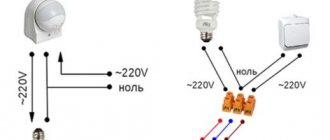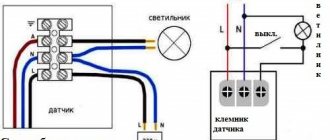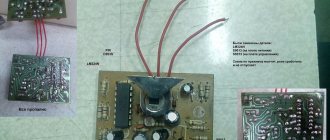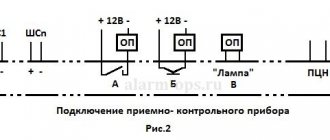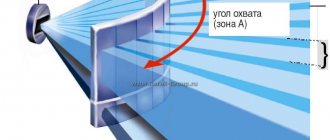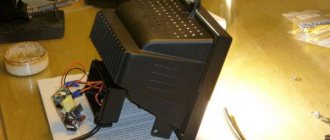Scope of application
The most popular street floodlights with motion detectors today are diode ones. They are the most economical and durable. They are used to illuminate the area near private houses for the design of garden and park landscapes. LEDs look best here. In addition, they are used for lighting:
- Border areas - as one of the signaling options.
- Industrial facilities.
- Warehouses.
- Parking lots.
- Other commercial properties.
Important! Such LED lights are functional, their sizes are small, and the installation and operation process is extremely simple. They are often installed for the entrance group.
Such widespread use can be explained by the numerous advantages of the device, including:
- Durability, especially for models with diodes.
- Easy to install.
- Do not require special maintenance.
- Economical. It is achieved by turning on only when necessary, for which the motion sensor is responsible and using the most economical lighting element at the moment.
- Resistance to negative environmental influences: noise, vibration, temperature changes, precipitation.
- Possibility of customization to the required parameters.
- Installation anywhere there is a solid base.
How to connect and configure a street lamp with a motion sensor
After a street light with a motion sensor is installed, it should be properly connected and configured. Connecting a lamp with a motion sensor is a simple procedure, without soldering, splicing wires, etc.
To do this, you need to open the cover of the motion sensor and connect an electrical wire to it. There should be inscriptions on the terminals of the motion sensor (L is the connected phase, N is correspondingly zero from the same incoming power cable). If there is only one connector each in the motion sensor N and L, then the wires from them are routed to the connected lamp.
Principle of operation
Motion sensors are used to organize advantageous street lighting. Their task is to turn on the spotlight while moving around the territory of the facility. Thus, a standard floodlight model with a photocell is capable of “seeing” movements within a radius of 10–12 m. This is quite enough to organize street lighting near a private house.
DDs that use electromagnetic and ultrasonic waves are considered the most effective and convenient. Their coverage area reaches 20 meters.
Any device of this type works as follows: when it enters the coverage area, an element is triggered, which is responsible for launching the spotlight. The light stays on for a certain amount of time depending on the settings.
Purpose of devices
An LED floodlight with DD illuminates the surrounding area when a moving object appears in the coverage area.
A floodlight with a motion sensor is designed to illuminate the adjacent area when a person or group of people is in the coverage area. After leaving the detection zone, the device turns off.
Common installation locations for LED lamps:
- territory adjacent to a residential building, summer cottages;
- bridges, tunnels, pedestrian crossings;
- parking lots and advertising banners;
- entrances of residential, public and administrative buildings;
- warehouses.
Do not use floodlights with sensors in work areas - a switched-off lamp can cause work-related injuries.
Installing lights with motion sensors in places where people are constantly present is impractical.
Equipment composition and operating principle
The functional diagram of a floodlight with a motion sensor includes:
- power supply for LED and sensor;
- LED matrix or separate LED;
- Motion Sensor;
- adjustable turn-off delay circuit;
- light sensor.
The operating algorithm of the spotlight is that power is supplied to the LEDs only when people or moving equipment appear in the detection zone. The delay unit will turn off the power after a predetermined time after the cessation of human movement (traffic). The light sensor blocks the operation of the device during daylight hours to eliminate “extra” on-off cycles.
The motion detector can be located in the same housing as the lamp or be remote.
Sensor types
LED spotlights use three types of motion detectors: radio wave, infrared, and sound.
Radio wave sensors are mainly used in outdoor lamps. These devices are of the active type.
Ultra-high frequency waves are emitted into space. Rays reflected from stationary objects return to the device with the same frequency. If a wave is reflected from a moving object, the frequency of the “returning” waves will be different from the emitted ones. The device monitors the change and, when a phenomenon is detected, supplies power to the LEDs.
Advantages of radio wave sensors:
- stable work regardless of the time of year;
- absence of false inclusions during gusts of wind and draft.
The disadvantage is the susceptibility to unnecessary triggering when operating in an area of strong electromagnetic interference from powerful electrical equipment.
Infrared sensors analyze the thermal temperature of surrounding objects, “remembering” the overall state in different segments.
When a person (equipment) appears in the detection zone, the sum of temperatures changes and the spotlight turns on. In hot weather, when the body temperature is close to surrounding objects, the sensor does not always see the difference, and the LEDs turn on intermittently. The same phenomenon occurs in winter, when a person is wearing warm clothes, the surface of which does not contrast much with the surrounding environment. Lights with infrared sensors are more suitable for indoor spaces or small courtyards.
Sound sensors respond to emerging noise, the source of which can be footsteps or a quiet conversation. Floodlights with this type of detector are better suited for enclosed spaces. For street lamps, the signal can be the sounds of a car passing in the distance or an airplane flying over.
Power type
Floodlight with DD on a solar battery
There are three types of devices according to the type of power supply:
- operating from a direct or alternating current network;
- wireless with built-in batteries;
- powered by batteries recharged by solar cells.
The first type is common in private homes and businesses. A 220 V household network or voltage from power supplies is used. Installing backup power supplies will allow you to use the device during short-term power outages.
Kinds
There are many options for street floodlights that are equipped with a motion sensor; there is plenty to choose from. Among the popular ones:
- LED with built-in motion sensor. They are most often used to illuminate the entrance of a car to a garage or house. Due to the ability to adjust the sensitivity, you can adjust it to your needs. At the same time, it reacts to objects of a certain size. For such flashlights, it is also possible to adjust other parameters, for example, the time frame, that is, the time for how long it will glow after activation.
- Floodlight with DD on solar batteries. It is convenient to use if it is not possible to connect to the electrical network or it is inconvenient to do so. Illuminates areas where an autonomous light source is needed. The solar panel is a separate element; it must be secured so that the maximum amount of sunlight falls on it. In the daytime, such a battery accumulates solar energy, and in the dark releases it, due to which the spotlight shines without being connected to the electrical network. The operating principle of such detectors is the same as that of other devices with a presence sensor.
- Spotlight with halogen lamp. It has an infrared motion sensor that responds to the emission of thermal energy from an object. The operating range of such a device reaches 12 m, and its functionality is not lost even at subzero temperatures, precipitation, or low temperatures.
Important! Street lamps often use an LED or halogen light source, much less often a fluorescent one. Modern floodlights with incandescent lamps cannot be found, since their use is irrational. First of all, this means several times more energy consumption. The second point is the difficulty of replacing a lamp, which often breaks down.
It makes sense to use flashlights with fluorescent lamps if there are no too high requirements regarding the light brightness of the rays. As for halogen ones, they are suitable for illuminating large areas, since their power reaches several kilowatts.
It is also worth highlighting the following models of floodlights with motion sensors:
- Spotlight and sensor in one housing. The most budget model, which is popular for installation in a summer cottage.
- The sensor is mounted on the spotlight, but in a separate housing. It can be installed above the front door in a private house.
- The sensor is separate from the spotlight. The sensor can be mounted in any convenient place.
How to make the right choice
You should choose based on the main characteristics of the device: coverage area, type of light source used, type of sensor used (IR, microwave, ultrasonic). Other important points:
- Since a floodlight with a motion sensor is selected for outdoor use, you should pay attention to models with a suitable protection index. The IP65 marking is considered optimal for outdoor use. This means that the device is protected from dust and moisture.
- Manufacturer. You should not be tempted by a low price, since the quality from an unknown brand often leaves much to be desired. Floodlights with presence sensors from Feron and Camelion are of recognized quality. They fulfill the declared service life at a high level.
- Appearance. This characteristic is not the main one, but the device should be selected so that it looks harmonious. This is generally not a problem since the spotlights are quite standard in appearance.
Sensor location
The way the sensor is connected to the main device plays an important role in which connection scheme will be chosen. Based on the type of sensor placement, there are spotlights where the sensor is located directly inside, under a single housing, as well as at another point in the lighting fixture. Models are sold with a sensor that must be mounted at a distance from the spotlight itself.
In the lamp body
Connecting such a device is simple; it does not require any special conditions. If the sensor is built inside or rigidly mounted on the housing, it is assembled with the main equipment in the factory. The product must be connected to the network in the usual way.
In a separate housing on the spotlight
When the sensor and the spotlight are independent of each other, they can be connected using different methods. The recommended connection option is always indicated in the instructions for use. You can also choose any typical scheme and use it. Most often, a direct connection to the network via a motion sensor is used. In such a situation, it will act as a simple switch, which is activated as soon as movement appears in the detection zone.
Installation
The spotlight can be installed on any flat surface. Often, pillars or a wall of the structure are used for this. Hardware should be selected that is reliable so that it can withstand the weight of the spotlight. Additional strengthening is carried out using clamps. Alternatively, you can integrate it into a niche. The sensor must be placed so that it is inaccessible to intruders, and at the same time the coverage area is as wide as possible based on its technical characteristics.
Connection
Even if you have practical skills, you should read the instructions before connecting any electrical device. If this is not done, there is a risk that the device, or more precisely, its sensor, will not work correctly.
Attention! Before carrying out any work with electrical cables, they should be de-energized by turning the corresponding toggle switch on the panel to the “off” position.
The spotlight is connected to the network using PVS or SHVVP wires. To also make grounding, you should choose a three-core cable. If you are connecting an LED spotlight, you can get by with a two-wire one.
Since the spotlight will be used constantly, it is better to provide for it not a socket, but a separate cable that comes from the panel or the nearest junction box.
Connection methods differ slightly depending on the type of spotlight (versions are suggested above). The first case is when the motion sensor is built into the body of the spotlight or rigidly fixed to it. This model is the easiest to connect, since the main difficulty - connecting the motion sensor to the lighting element - disappears. All that is needed in this case is to insert the power wire into the spotlight box. Some models even have connections for connection, so you don't have to disassemble the device.
If the motion sensor is placed separately from the spotlight, then the connection is somewhat more complicated, but you can still connect it yourself. The first thing you need to do is connect the motion sensor to the spotlight using a separate cable. Here it is also important to connect the wires carefully, otherwise there is a risk that if it connects to the network, the spotlight will simply burn out.
The connection diagram looks like this:
The main attention should be paid to connecting cables with appropriate markings. Brown is connected to the phase one, red is connected to the output from the spotlight. The second wire of the device and the blue cable to neutral. The color of the cables may vary; please refer to the manufacturer's instructions.
Settings
Setting up a floodlight with a motion sensor, or more precisely, the sensor itself, is not difficult. It is important to know the order of this process. Most sensors have 3 main characteristics that affect whether the spotlight turns on/off. More specifically:
- Day Light. This adjustment helps adjust the sensor's sensitivity to outdoor light. When configured correctly, the spotlight turns on only at night, and does not trigger on moving objects during the day. By setting the extreme left position, the device is programmed to turn on in the dark. The extreme right position starts the floodlight to work around the clock.
- Time. The regulator makes it possible to set the glow time, that is, how long after switching on the light is on. The minimum threshold in most devices is 5 seconds, maximum 5 minutes. After the set time, the light will turn off.
- Sens. The third adjustment is not available in every device. If it is present, it will help configure the device to trigger an object of a certain size. That is, to exclude false activation of the spotlight if a medium-sized cat or dog runs by.
It is recommended to carry out all settings experimentally; in this case, it will be possible to achieve the required clarity of operation in each specific case. Often a motion sensor is part of a security system; if conditions are met, it can be connected to a siren.
How to Disable the Motion Sensor on a Lamp
Connecting lighting devices via motion sensor
To ensure safety and increase comfort for people, motion sensors have recently been added to conventional lamps. They are designed to respond in the control area. As they move, they transmit a signal through wires to a lighting device, which turns on the light. Previously, such devices were used only for security purposes, but now they are widely popular in private homes and apartments. They perform the following functions:
- prevent the search for a switch in a black room;
- save energy by turning off when motion is not detected;
- may cause alarm and scare away intruders.
Externally, such lighting devices are represented by a plastic rectangular or round box covered with a Fresnel lens. Through it, the device controls movements in the control zone. The Fresnel lens is made of a fairly fragile and narrow material that requires special care when installing the lighting fixture. Additionally, during installation, it is important to consider the size of people or animals that will be passing through the sensor area.
sensor with built-in light
When choosing a lamp with a controller, you need to pay attention to its appearance:
- stationary. does not move like a person moves;
- mobile. rotates to the side where it was secured to move , and is often used for safety purposes.
Depending on the type of detector it may be:
- active. work on the sonar principle;
- Passive. work through detecting human body heat.
Typically, the detector's range is limited to 12 m. If installed indoors or on an area that is not rectangular, you will need to purchase additional lighting fixtures with detectors.
READ Where is the Speed Sensor on Ford Focus 2
Electrical circuits Motion sensor
Content
Connecting a motion controller to a lighting device
Connecting a motion sensor according to the diagram is a normal operation, reminiscent of connecting a regular switch. This makes sense because this device, like a switch, opens and closes a contact through the electrical circuit in which the lighting fixture is located.
Typically, a schematic diagram of a motion controller according to the circuit is added along with an annotation or shown on the packaging of the device case.
According to the diagram, there are two types of sensor power wires: phase (coffee conductor) and neutral (blue wire). When a phase leaves it, it is transferred to one of the two ends of the lamp in the lighting device and vice versa. When the controller is activated, the relay contact closes, resulting in a phase change.
LED lamp with motion sensor NAVIGATOR
Business cards required. order them here lamp
You can buy one at ETM.
As a motion (presence) sensor and
Subscribe to our VKontakte group. and Facebook.
To connect the motion controller to the lamp according to the diagram, you must:
- Remove the back cover and locate the terminal block. There are 3 wires connected to it coming out of the device body;
- look at the diagram shown in the annotation or on the case, connect the wire from the sensor to the corresponding wire in the device case;
- after connecting the controller Back cover;
- To connect the wiring in the junction box, where there are 7 wires (3 from the motion sensor, 2 from the lamp, as well as zero and phase), the phase wire of the power cable is connected together with the phase wire from the motion controller. After “0”, the wire from the power cable is connected to a similar wire from the lamp and sensor. Last step. connect the remaining 2 wires.
READ Where is the Nissan Sunny crankshaft sensor located?
Connecting the switch to the sensor
Some users of lamps equipped with motion sensors prefer to connect through a common circuit and a switch. This is necessary so that in some cases the light will turn on regardless of the sensor's operation, for example, when it is standing still or turning on the light in a room or yard before entering it.
Schematic diagram of connecting a motion sensor for lighting operating in two modes, as well as a motion sensor switch
To connect the switch you need to follow a simple diagram that can be found on the Internet. According to her, the switch will duplicate the functions of the sensor, in some cases forcibly controlling the light. This scheme assumes a parallel connection of the switch and controller.
When the switch is active in the circuit, the light will not go out for the required period, and when it is turned off, the light will be adjusted through the controller.
settings Motion sensor
In addition to wiring, you also need to adjust the motion sensor for the lighting by adjusting the following parameters:
- Backlight (LUX);
- shutdown delay(TIME);
- sensitivity to infrared rays (SENS).
By adjusting the time setting, you can set the interval for the lighting to turn on from the moment motion is detected in the controlled area. Typically this value for luminaires ranges from 1 to 600 seconds. A person's speed also plays an important role in establishing the time period. It also depends on whether the controller will work. If a person quickly passes through the control zone, it is better to reduce the time the light is on. Conversely, when installing such a device in a garage or utility room, it would be logical to set a longer shutdown delay.
READ Where is the Camshaft Sensor on the VAZ 2114
Adjusting motion sensors
As for the LUX lighting parameter, it adjusts the lamp operation day and night. Time of day. If the light level outdoors or indoors drops to a certain point, the light turns on. You can also change the lighting threshold yourself.
Setting the LUX parameter to the maximum separation scale is recommended when there is insufficient daylight and vice versa.
Many motion sensors in fixtures can also adjust sensitivity to activate SENS lighting. The controller's response depends on what level of object sensitivity is set there. If the Motion Sensor quite often causes or “sees” the slightest vibrations, the sensitivity should be reduced. By simply returning the lamp to the desired point, you can also change it. You can also install:
- range (no more than the maximum, which usually reaches 10-12 m);
- volume (if you don't want the lamp including thanks to a flying bird).
By the way, many outdoor models require adjustments in winter and summer. Some indicators may be mixed up.
